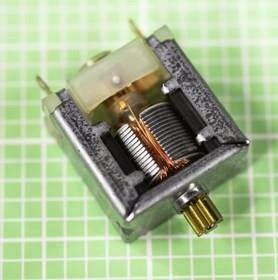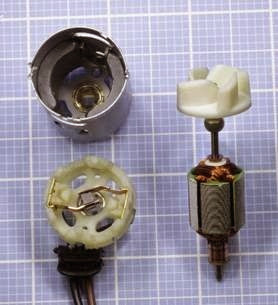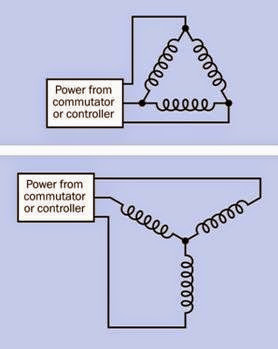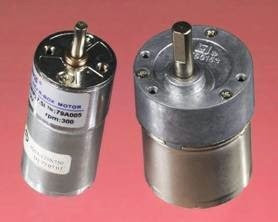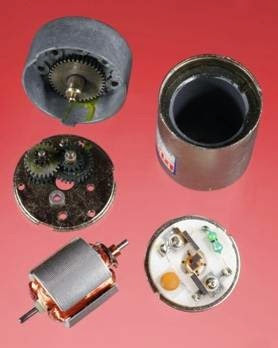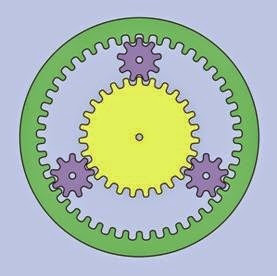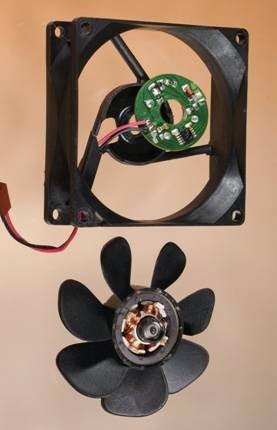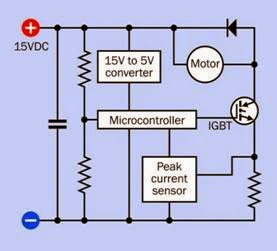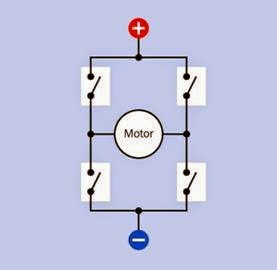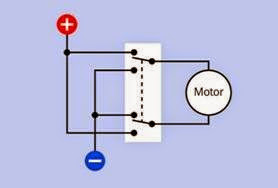In this section, the term “traditional DC motor” is used to describe the oldest and simplest design, which consists of two brushes delivering power via a rotating, sectioned com mutate to two or more electromagnetic coils mounted on the motor shaft. Brushless DC motors (in which DC is actually converted to a pulse train) are also described here because “brushless DC” has become a commonly used phrase, and the motor is powered by direct current, even though this is modified internally via pulse-width modulation.
A traditional DC motor uses direct current to cre ate magnetic force, which turns an output shaft. When the polarity of the DC voltage is reversed, the motor reverses its direction of rotation. Usu ally, the force created by the motor is equal in either direction.
How It Works
Current passes through two or more coils that are mounted on the motor shaft and rotate with it. This assembly is referred to as the rotor. The mag netic force produced by the current is concen trated via cores or poles of soft iron or high- silicon steel, and interacts with fields created by permanent magnets arrayed around the rotor in a fixed assembly known as the stator.
Power to the coils is delivered through a pair of brushes, often made from a graphite compound. Springs press the brushes against a sleeve that rotates with the shaft and is divided into sections, connected with the coils. The sleeve assembly is
known as the commutator. As the com mutator rotates, its sections apply power from the brushes to the motor coils sequentially, in a simple mechanical switching action.
The most elementary configuration for a traditional DC motor is shown in Figure 22-1.
In reality, small DC motors typically have three or more coils in the rotor, to provide smoother operation. The operation of a three-coil motor is shown in Figure 22-2. The three panels in this figure should be seen as successive snapshots of one motor in which the rotor turns progressively counter-clockwise. The brushes are colored red and blue to indicate positive and negative volt age supply, respectively. The coils are wired in series, with power being applied through the commutator to points between each pair of coils. The direction of current through each coil deter mines its magnetic polarity, shown as N for north or S for south. When two coils are energized in series without any power applied to their mid point, each develops a smaller magnetic field than an individually energized coil. This is
Figure 22-1. The simplest traditional DC motor contains these parts. The combination of coil, shaft, and commuta- tor is the rotor. The fixed magnetic structure in which it rotates is the stator.
indicated in the diagram with a smaller white lowercase n and s. When two ends of a coil are at equal potential, the coil produces no magnetic field at all.
The stator consists of a cylindrical permanent magnet, which has two poles—shown in the fig ure as two black semicircles separated by a vertical gap for clarity—although in practice the magnet may be made in one piece. Opposite magnetic poles on the rotor and stator attract each other, whereas the same magnetic poles repel each other.
DC motors may be quite compact, as shown in Figure 22-3, where the frame of the motor meas ures about 0.7” square. They can also be very powerful for their size; the motor that is shown disassembled in Figure 22-4 is from a 12VDC bilge pump rated at 500 gallons per hour. Its out
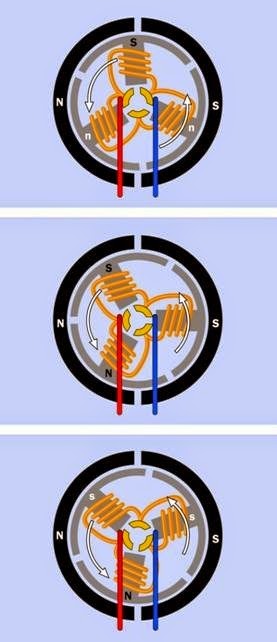 Figure 22-2. Three sequential views of a typical three-coil DC motor viewed from the end of its shaft (the shaft itself is not shown). Magnetic effects cause the rotor to turn, which switches the current to the coils via the commutator at the center.
Figure 22-2. Three sequential views of a typical three-coil DC motor viewed from the end of its shaft (the shaft itself is not shown). Magnetic effects cause the rotor to turn, which switches the current to the coils via the commutator at the center.
put was delivered by the small impeller attached to the rotor at right, and was achieved by using
two extremely powerful neodymium magnets, just visible on the inside of the motor’s casing (at top-left) in conjunction with five coils on the rotor.
Figure 22-3. A miniature 1.5VDC motor measuring about 0.7” square.
Variants
Coil Configurations
The series connection of coils used in Figure 22-2 is known as the delta configuration. The alternative is the wye configuration (or Y configuration, or star configuration). Simplified schematics are shown in Figure 22-5. Generally speaking, the delta configuration is best suited to high-speed applications, but provides relatively low torque at low speed. The wye configuration provides higher torque at low speed, but its top speed is limited.
Gearhead Motor
A gearhead motor (also often known as a gear motor) incorporates a set of reduction gears that increase the torque available from the output shaft while reducing its speed of rotation. This is often desirable as an efficient speed for a traditional DC motor may range from 3,000 to 8,000
Figure 22-4. A traditional DC motor removed from its cylindrical casing. The brushes of the motor are attached to the white plastic end piece at bottom-left. Large squares on the graph paper in the background are 1” × 1”, divided in 0.1” increments. The motor was used in a small bilge pump.
RPM, which is too fast for most applications. The gears and the motor are often contained in a single sealed cylindrical package. Two examples are shown in Figure 22-6. A disassembled motor, revealing half of its gear train under the cap and the other half still attached to a separate circular plate, appears in Figure 22-7. When the motor is assembled, the gears engage. As in the case of the bilge-pump motor, the stator magnets are mounted inside the cylindrical casing. Note that the brushes, inside the circular plate of white plastic, have a resistor and capacitor wired to suppress voltage spikes.
Spur gears are widely used for speed reduction. Planetary gears (also known as epicyclic gears) are a slightly more expensive option. Spur gears such as those in Figure 22-8 may require three or more pairs in series. The total speed reduction is
Figure 22-5. Coils on the rotor of a traditional DC motor may be connected in delta configuration (top) or wye con- figuration (bottom).
Figure 22-6. Two typical small gearhead motors.
found by multiplying the individual ratios. Thus, if three pairs of gears have ratios of 37 : 13, 31 : 15, and 39 : 17, the total speed reduction ® is obtained by:
R = ( 37 * 31 * 39 ) / ( 13 * 15 * 17 )
Figure 22-7. Spur gears from a gearhead motor provide speed reduction and increased torque.
Therefore:
R = 44733 / 3315 = about 13.5 : 1
Datasheets almost always express R as an integer. For example, the gear train shown in Figure 22-7 is rated by the manufacturer as having an overall reduction of 50:1. In reality, the reduction can be expected to have a fractional component. This is because if two gears have an integer ratio, their operating life will be shortened, as a manufac turing defect in a tooth in the smaller gear will hit the same spots in the larger gear each time it rotates. For this reason, the numbers of teeth in two spur gears usually do not have any common factors (as in the example above), and if a motor rotates at 500 RPM, a gear ratio stated as 50:1 is very unlikely to produce an output of exactly 10
RPM. Since traditional DC motors are seldom used for applications requiring high precision, this is not usually a significant issue, but it should be kept in mind.
Figure 22-8. A pair of spur gears.
Figure 22-9 shows planetary gears, also known as epicyclic gears. The outer ring gear is properly re ferred to as the annulus, while the sun gear is at the center, and the intermediate planet gears may be mounted on a carrier. The greatest speed reduction will be achieved by driving the sun gear while the annulus is kept in a stationary position and the output is taken from the carrier of the planet gears. If A is the number of teeth in the annulus and S is the number of teeth in the sun gear, the total speed reduction, R, is given by the following formula:
R = (S + A) / S
Note that in this drive configuration, the number of teeth in each planet gear is irrelevant to the speed reduction. In Figure 22-9, the sun gear has 27 teeth whereas the annulus has 45 teeth. Therefore, the reduction is found by:
R = (27 + 45) / 27 = about 2.7 : 1
Successive reductions can be achieved by stack ing planetary gear sets, using the carrier of one set to drive the sun gear in the next set.
Planetary gears are used primarily if a motor drives a heavy load, as the force is divided among
Figure 22-9. Planetary gears, also known as epicyclic gears, share the torque from a motor among more teeth than simple spur gears.
more gear pairs, reducing wear and tear on gear teeth and minimizing the breakdown of lubrication. A planetary gear train may also be more compact than a train of spur gears. These advan tages must be evaluated against the higher price and slightly increased friction resulting from the larger number of gears interacting with each other.
Brushless DC Motor
In a brushless DC motor, sometimes referred to as a BLDC motor, the coils are located in the stator and the permanent magnets are relocated in the rotor. The great advantage of this design is that power can be applied directly to the coils, eliminating the need for brushes, which are the primary source of failure in DC motors as a result of wear and tear. However, since there is no rotating commutator to switch the DC current to the coils, the current must be switched by electronic com ponents, which add to the cost of the motor.
In the inrunner configuration the stator surrounds the rotor, whereas in the outrunner con figuration the stator is located in the center of the motor while the rotor takes the form of a ring or
cup that spins around the stator. This is a common design for small cooling fans, where the blades are attached to the outer circumference of a cup that is lined with permanent magnets. An example is shown in Figure 22-10. In this pic ture, the stator coils are normally hidden from view, being fixed to the fan housing (shown at the top of the picture). Power is controlled by the surface-mount components on the green circu lar circuit board. The cup attached to the fan blades contains permanent magnets.
Figure 22-10. A typical brushless DC cooling fan uses stationary coils, with permanent magnets rotating around them.
The use of a solid-state switching system to energize the coils sequentially is known as electronic commutation. Hall effect sensors may be used to detect the position of the rotor and feed this information back to the frequency control circuit,
so that it stays “one step ahead” of the rotor (when bringing it up to speed) or is synchronized with the rotor (for a constant running speed). The system is comparable to a reluctance motor or synchronous motor. These variants are described in the AC motor section of this encyclopedia.
While traditional DC motors have been commercially available since the late 1800s, brushless DC motors were not introduced until the 1960s, when the availability of solid-state control electronics began to make the motor design economically viable.
Linear Actuator
Linear actuator is a generic term for any device that can exert a pushing or pulling force in a straight line. In industrial applications, actuators may be powered pneumatically or hydraulically, but smaller-scale units are usually driven by a traditional DC motor. These are more properly (but not often) referred to as electromechanical linear actuators.
The rotational force of the motor is typically converted to linear motion by using a threaded motor shaft in conjunction with a nut or collar. The unit is often mounted in an enclosure containing limit switches that stop the motor automatically at the limits of travel. For an explanation of limit switches, see “Limit Switches” (page 46) in the switch entry in this encyclopedia.
Values
A manufacturer’s datasheet should list the max imum operating voltage and typical current consumption when a motor is moderately loaded, along with the stall current that a motor draws when it is so heavily loaded that it stops turning. If stall current is not listed, it can be determined empirically by inserting an ammeter (or multi meter set to measure amperes) in series with the motor and applying a braking force until the motor stops. Motors should generally be protected with slow-blowing fuses to allow for the power fluctuations that occur when the motor starts running or experiences a change in load.
In addition, the torque that a motor can deliver should be specified. In the United States, torque is often expressed in pound-feet (or ounce- inches for smaller motors). Torque can be visualized by imagining an arm pivoted at one end with a weight hung on the other end. The torque exerted at the pivot is found by multiplying the weight by the length of the arm.
In the metric system, torque can be expressed as gram-centimeters, Newton-meters, or dyne- meters. A Newton is 100,000 dynes. A dyne is de fined as the force required to accelerate a mass of 1 gram, increasing its velocity by 1 centimeter per second each second. 1 Newton-meter is equivalent to approximately 0.738 pound-feet.
The speed of a traditional DC motor can be adjusted by varying the voltage to it. However, if the voltage drops below 50% of the rated value, the motor may simply stop.
The power delivered by a motor is defined as its
In the hobby field, motors for model aircraft are typically rated in watts-per-pound of motor weight (abbreviated w/lb). Values range from 50 to 250 w/lb, with higher values enabling better performance.
Relationships between torque, speed, voltage, and amperage in a traditional DC motor can be described easily, assuming a hypothetical motor that is 100% efficient:
If the amperage is constant, the torque will also be constant, regardless of the motor speed.
If the load applied to the motor remains constant (thus forcing the motor to apply a constant torque), the speed of the motor will be determined by the voltage applied to it.
If the voltage to the motor remains constant, the torque will be inversely proportional with the speed.
How to Use it
speed multiplied by its torque at that speed. The
greatest power will be delivered when the motor is running at half its unloaded speed while delivering half the stall torque. However, running a motor under these conditions will usually create unacceptable amounts of heat, and will shorten its life.
Small DC motors should be run at 70% to 90% of their unloaded speed, and at 10% to 30% of the stall torque. This is also the range at which the motor is most efficient.
Ideally, DC motors that are used with reduction gearing should be driven with less than their rat ed voltage. This will prolong the life of the motor.
When choosing a motor, it is also important to consider the axial loading (the weight or force that will be imposed along the axis or shaft of the motor) and radial loading (the weight or force that will be imposed perpendicularly to the axis). Maximum values should be found in motor da tasheets.
A traditional DC motor has the advantages of cheapness and simplicity, but is only suitable for intermittent use, as its brushes and commutator will tend to limit its lifetime. Its running speed will be approximate, making it unsuitable for precise applications.
As the cost of control electronics has diminished, brushless DC motors have replaced traditional DC motors. Their longevity and controllability provide obvious advantages in applications such as hard disk drives, variable-speed computer fans, CD players, and some workshop tools. Their wide variety of available sizes, and good power- to-weight ratio, have encouraged their adoption in toys and small vehicles, ranging from remote- controlled model cars, airplanes, and helicopters to personal transportation devices such as the Segway. They are also used in direct-drive audio turntables.
Where an application requires the rotation of a motor shaft to be converted to linear motion, a prepackaged linear actuator is usually more reliable and simpler than building a crank and
connecting rod, or cam follower, from scratch. Large linear actuators are used in industrial au tomation, while smaller units are popular with robotics hobbyists and can also be used to con trol small systems in the home, such as a remote- controlled access door to a home entertainment center.
Speed Control
A rheostat or potentiometer may be placed in series with a traditional DC motor to adjust its speed, but will be inefficient, as it will achieve a voltage drop by generating heat. Any rheostat must be rated appropriately, and should probably be wire-wound. The voltage drop between the wiper and the input terminal of the rheostat should be measured under a variety of operating conditions, along with the amperage in the circuit, to verify that the wattage rating is appropriate.
Pulse-width modulation (PWM) is preferable as a means of speed control for a traditional DC motor. A circuit that serves this purpose is some times referred to as a chopper, as it chops a steady flow of current into discrete pulses. Usually the pulses have constant frequency while varying in duration. The pulse width determines the aver age delivered power, and the frequency is sufficiently high that it does not affect smoothness of operation of the motor.
A programmable unijunction transistor or PUT can be used to generate a train of pulses, adjustable with a potentiometer attached to its emitter. Output from the transistor goes to a silicon-controlled rectifier (SCR), which is placed in series with the motor, or can be connected directly to the motor if the motor is small. See Figure 27-7.
Alternatively, a 555 timer can be used to create the pulse train, controlling a MOSFET in series with the motor.
A microcontroller can also be used as a pulse source. Many microcontrollers have PWM capability built in. The microcontroller will require its
own regulated power supply (typically 5VDC, 3.3VDC, or sometimes less) and a switching component such as an insulated-gate bipolar transistor (IGBT) to deliver sufficient power to the motor and to handle the flyback voltage. These components will all add to the cost of the system, but many modern devices incorporate microcontrollers anyway, merely to process user input. An other advantage of using a microcontroller is that its output can be varied by rewriting soft ware, for example if a motor is replaced with a new version that has different characteristics, or if requirements change for other reasons. Additionally, a microcontroller enables sophisticated features such as pre-programmed speed se quences, stored memory of user preferences, and/or responses to conditions such as excessive current consumption or heat in the motor.
A PWM schematic using a microcontroller and IGBT is shown in Figure 22-11.
Figure 22-11. A sample schematic for control of a DC mo- tor via pulse-width modulation, using a microcontroller and an insulated-gate bipolar transistor.
Direction Control
The H bridge is a very early system for reversing the direction of a DC motor simply by swapping the polarity of its power supply. This is shown in Figure 22-12. The switches diagonally opposite
each other are closed, leaving the other two switches open; and then to reverse the motor, the switch states are reversed. This is obviously a primitive scheme, but the term “H bridge” is still used when prepackaged in a single chip such as the LMD18200 H bridge motor controller from National Semiconductor.
Figure 22-12. A DC motor can be reversed by this very basic circuit, known as an H bridge, by opening and closing pairs of switches that are diagonally opposite each other.
A double-throw, double-pole switch or relay can achieve the same purpose, as shown in Figure 22-13.
Limit Switches
When a traditional DC motor is used reversibly within a restricted range of motion, it can be fit ted with limit switches to prevent the motor from stalling and burning out at either end of its per mitted travel. Limit switches are explained in “Limit Switches” (page 46) in the switch entry in this encyclopedia.
Figure 22-13. A DPDT switch or relay can reverse the direction of a traditional DC motor simply by swapping the polarity of the power supply.
What Can Go Wrong
Brushes and Commutator
The primary cause of failure in DC motors is abrasion of the brushes and wear and tear, oxidation, and/or accumulation of dirt on the commutator. Some motors are designed to allow replacement of the brushes; sealed motors and gearhead motors generally are not. High current and high speed will both tend to accelerate wear in the areas where the brushes meet the commutator.
Electrical Noise
The intermittent contact between the brushes and sections of the com mutator of a traditional DC motor can induce voltage spikes that may travel back into the power supply for the motor and cause seemingly random effects in other components. Sparking in the commutator can be a significant source of electromagnetic interference (EMI), especially where cheap or poorly fit ted brushes are used. Even if the commutator is running cleanly, the rapid creation of a magnetic field in a motor winding, following by collapse of the field, can create spikes that feed back into the power supply.
Wires that power a motor should be in twisted- pair configuration, so that their radiated EMI tends to cancel itself out. They should be routed
away from data lines or encoder outputs, and may be shielded if necessary. Data lines from sensors in brushless motors may also be shielded.
Installing a capacitor across the motor terminals can significantly reduce EMI. Some motors have capacitors preinstalled. If the motor is in a sealed casing, it may have to be disassembled to reveal whether a capacitor is present.
Heat effects
Since all motors in the real world are less than 100% efficient, some power is lost by the motor during normal operation, and will be dissipated as heat. The resistance of motor windings, and consequently the magnetic force that they generate, will decrease as the temperature rises. The motor becomes less efficient, and will try to draw more current, worsening the situation. A manu facturer’s rating for maximum temperature should be taken seriously.
The insulation of the coil windings is usually the most vulnerable part of a motor if excess heat persists. Short circuits between adjacent coils as a result of insulation breakdown will degrade the performance of the motor while increasing its power consumption, which will create even more heat.
Where motor casings have protruding ridges, these cooling fins should be exposed to ambient air.
Frequent starting, stopping, and reversing will tend to generate heat as a result of power surges, and will reduce the lifetime of the motor.
Ambient Conditions
A warm, dry environment will tend to dry out bearing lubricants and graphite brushes. Con versely, a very cold environment will tend to thicken the bearing lubricants. If a motor will be used in unusual environmental conditions, the manufacturer should be consulted.
Wrong Shaft Type or Diameter
Motors have a variety of possible output shaft diameters, some measured in inches and others in millimeters, and shafts may be long or short,
or may have a D-shaped cross section or splines
to mate with appropriate accessories such as gears, pulleys, or couplings. Careful examination of datasheets and part numbers is necessary to determine compatibility. In the hobby- electronics world, retailers may offer purpose- built discs or arms for specific motor shafts.
Incompatible Motor Mounts
Mounting lugs or flanges may or may not be pro vided, and may be incompatible with the application for which the motor is intended. The same
motor may be available with a variety of mount
options, differentiated only by one letter or digit in the motor’s part number. A mount option that was available in the past may become obsolete or may simply be out of stock. Again, examina tion of datasheets is necessary.
Backlash
Backlash is the looseness or “slack” in a gear train that results from small gaps between meshing gear teeth. Because backlash is cumulative when gears are assembled in series, it can become sig nificant in a slow-output gearhead motor. When measured at the output shaft, it is generally in the range of 1 to 7 degrees, tending to increase as the load increases. If a geared motor is used as a positioning device, and is fitted with an encoder to count rotations of the motor shaft, control electronics may cause the motor to hunt to and fro in an attempt to overcome the hysteresis al lowed by the backlash. A stepper motor or servo motor is probably better suited to this kind of application.
Bearings
When using a motor that is not rated for signifi cant axial loading, the bearings may be damaged by applying excessive force to push-fit an output
gear or pulley onto the motor shaft. Even minor damage to bearings can cause significant noise (see the following section) and a reduced lifetime for the component.
In brushless DC motors, the most common cause of failure is the deterioration of bearings. At tempting to revive the bearings by unsealing them and adding lubricant is usually not worth the trouble.
Audible Noise
While electric motors are not generally thought of as being noisy devices, an enclosure can act as a sounding board, and bearing noise is likely to increase over time. Ball bearings become noisy over time, and gears are inherently noisy.
If a device will contain multiple motors, or will be used in close proximity to people who are likely to be sensitive to noise (for example, in a medical environment), care should be taken to insure that motor shafts are properly balanced, while the motors may be mounted on rubber bushings or in sleeves that will absorb vibration.


